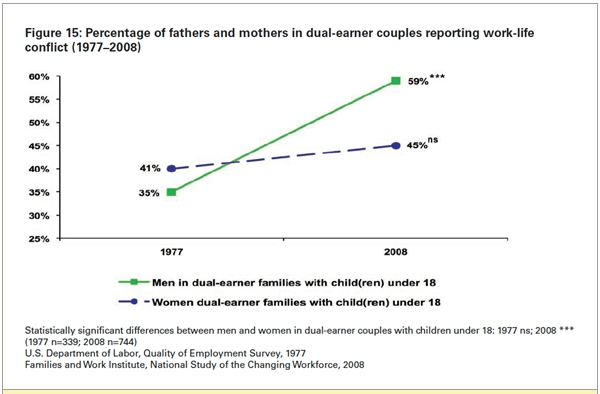|
|
Right up front, I will admit my bias here. I've always found the advertisements and shows that portray dads as the bumbling idiots to be pretty insulting. I think it demeans how dedicated many men are to their kids and being a good dad.
It's not that we can't laugh at ourselves, but from a marketing point of view — I may find it funny but I sure don't see myself in the portrayal. So if you want to amuse me…have at it. If you want me to buy something, you'd better find a different avenue.
That's why I found this recent study from the nonprofit Families and Work Institute (FWI) so fascinating. What the study suggests is that men are now feeling the same pressures to balance their lives and that pressure is causing a lot of stress.
It suggests that perhaps it's time for marketers to re-think how they target and talk to men. I'm curious what you think…do you think this sort of study gives us new insights? Or do you think marketing is ahead of the research and we already knew this?
Here's some of the study's data and analysis.
The study traces the trends in men’s and women’s attitudes and actions over the past three decades, reveals that changing gender roles have significantly and specifically increased the overall level of work-life conflict experienced by men, from 34% in 1977 to 45% in 2008. On the other hand, the rise in women’s work-life conflict, which increased from 34% in 1977 to 39% in 2008, has been less dramatic and is not statistically significant.
Fathers in dual-earner couples are spending more time with their children but are experiencing more work life conflict than mothers. In 1977, 35% reported experiencing some or a lot of conflict. In 2008, that figure has risen to 59%. The level of conflict experienced by mothers in dual-earner families has not changed much during that time period (41% in 1977 and 45% in 2008).
Working Women Can Be Good Mothers
Greater proportions of both men and women agree that employed women can be good mothers, the study found. In 1977, 49% of men agreed (strongly or somewhat) that a mother who works outside the home can have just as good a relationship with her children as a mother who does not work. Today, 67% agree. From 1977 to 2008, the percentage of women agreeing moved from 71% in to 80%. Both men and women who grew up with employed mothers have greater acceptance of working mothers than those whose mothers did not work outside the home.
Fathers Spend More Time with Kids
Employed fathers, especially Millennials, are spending more time with children today than their age counterparts did three decades ago, while employed mothers’ time has not changed significantly. On average, employed fathers of all ages spend 3.0 hours per workday with children under 13 today compared with 2.0 hours in 1977. For employed mothers of all ages, time spent with children has remained at 3.8 hours. Today’s Millennial fathers spend 4.3 hours per workday compared with the 2.4 hours spent by their age counterparts in 1977. Mothers under 29 today average 5.0 hours compared with 4.5 hours in 1977.
Men also say they are taking more overall responsibility for the care of their children. In 1992, 21% of women said that their spouses or partners were taking as much or more responsibility for the care of their children as they were. By 2008, that percentage has risen to 31%.
Interestingly, FWI noted, 49% of men report taking as much or more responsibility for the children as their wives, indicating a perception gap.
The report states that the gradual increase of women in the labor force over the past half century, combined with various work life trends and economic pressures, has resulted in a shrinking gap between how men and women view their careers, family roles, and the fit between their lives on and off the job.
“Our findings are striking and surprising,” said Ellen Galinsky, president and co-founder of FWI and lead author of the study. “There are many firsts in this study – the first time that younger men and women feel the same about job advancement and the first time that there is no statistically significant difference between men and women in their views of appropriate gender roles.”
You can read the whole report: “Times Are Changing: Gender and Generation at Work and At Home,” (pdf) examines the evolution of work-related gender roles over the past three decades.


![Reblog this post [with Zemanta]](http://img.zemanta.com/reblog_e.png?x-id=a577e274-962d-47b6-ab36-b7581bae80cc)